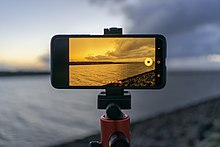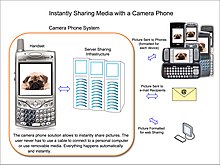
Back Telèfon amb càmera Catalan Mobiltelefon#Kamera German Teléfono con cámara fotográfica Spanish گوشی دوربیندار Persian Kamerapuhelin Finnish Photophone (appareil) French カメラ付き携帯電話 Japanese 카메라폰 Korean Telefon bimbit berkamera Malay کیمرہ فون PNB


A camera phone is a mobile phone which is able to capture photographs and often record video using one or more built-in digital cameras. It can also send the resulting image wirelessly and conveniently. The first commercial phone with color camera was the Kyocera Visual Phone VP-210, released in Japan in May 1999.[1]
Most camera phones are smaller and simpler than the separate digital cameras. In the smartphone era, the steady sales increase of camera phones caused point-and-shoot camera sales to peak about 2010 and decline thereafter.[2] The concurrent improvement of smartphone camera technology, and its other multifunctional benefits, have led to it gradually replacing compact point-and-shoot cameras.[3]
Most modern smartphones only have a menu choice to start a camera application program and an on-screen button to activate the shutter.[4] Some also have a separate camera button, for quickness and convenience. A few such as the 2009 Samsung i8000 Omnia II have a two-level shutter button as in dedicated digital cameras.[5] Some camera phones are designed to resemble separate low-end digital compact cameras in appearance and to some degree in features and picture quality, and are branded as both mobile phones and cameras—an example being the 2013 Samsung Galaxy S4 Zoom.
The principal advantages of camera phones are cost and compactness; indeed for a user who carries a mobile phone anyway, the addition is negligible. Smartphones that are camera phones may run mobile applications to add capabilities such as geotagging and image stitching. Also, modern smartphones can use their touch screens to direct their camera to focus on a particular object in the field of view, giving even an inexperienced user a degree of focus control exceeded only by seasoned photographers using manual focus. However, the touch screen, being a general purpose control, lacks the agility of a separate camera's dedicated buttons and dial(s).
Starting in the mid-2010s, some advanced camera phones feature optical image stabilisation (OIS), larger sensors, bright lenses, 4K video and even optical zoom, for which a few use a physical zoom lens. Multiple lenses and multi-shot night modes are also familiar.[6] Since the late 2010s, high-end smartphones typically have multiple lenses with different functions, to make more use of a device's limited physical space. Common lens functions include an ultrawide sensor, a telephoto sensor, a macro sensor, and a depth sensor. Some phone cameras have a label that indicates the lens manufacturer, megapixel count, or features such as autofocus or zoom ability for emphasis, including the Samsung Omnia II (2009) and Galaxy S II (2011) and S20 (2020), Sony Xperia Z1 (2013) and some successors, Nokia Lumia 1020 (2013).
- ^ "Image of kyocera visual phone vp-210, japan, 2008". Science & Society Picture Library. Archived from the original on 2021-07-24. Retrieved 2021-10-12.
- ^ "Camera Sales in 2020 Have Plummeted as Much as 54%". PetaPixel. 6 November 2020. Archived from the original on 2021-04-14. Retrieved 2021-05-22.
- ^ "StackPath". 21 November 2012. Archived from the original on 2021-09-17. Retrieved 2021-09-17.
- ^ "Motorola DROID X vs. HTC Droid Incredible". Phone Arena. 28 April 2011. Archived from the original on 2011-12-28.
- ^ "Review: Samsung Omnia II's Camera". Windows Central. 28 January 2010. Archived from the original on 13 November 2020. Retrieved 13 November 2020.
- ^ "Top 16 Best Camera Phones For Photography 2019". April 4, 2019. Archived from the original on May 12, 2019. Retrieved May 12, 2019.
© MMXXIII Rich X Search. We shall prevail. All rights reserved. Rich X Search